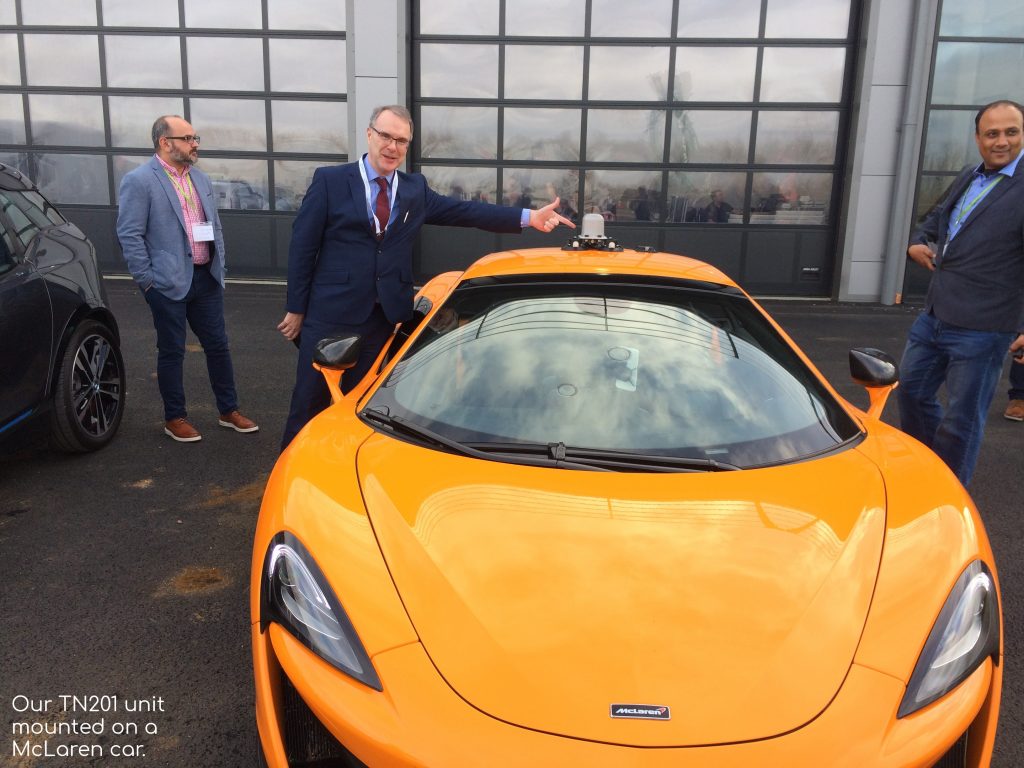6 landmark 5G developments revealed at AutoAir
by Blu Wireless
On Tuesday, the eagerly anticipated AutoAir Testbed came to fruition at Millbrook Proving Ground, demonstrating the work of Blu Wireless and its consortium partners, led by Airspan.
The government-funded 5G Testbed has successfully shown the feasibility of achieving super-fast connectivity of up to 1Gbps between vehicles travelling at high speeds. This is not only a key benchmark for future connected autonomous vehicles (CAVs) applications but also to delivering improved wireless services for rail passengers. mmWave wireless technology has been crucial to these developments due to availability of the necessary GHz’s of wireless spectrum at mmWave frequencies.
Here are six important take-aways from the event, including some bold predictions, recommendations for building the business case for 5G and calls for further collaboration to develop the technology:
1. 4K video data sharing between vehicles will vastly improve road safety
At the testbed’s 5G connected highway – enabled by a hyper-dense mobile network comprising 60 small cells providing Non-Line-of-Sight (NLOS) coverage and 22 mmWave nodes providing Line-of-Sight (LOS) backhaul and high-speed mobility – 4K video data was shared between cars at different points of the track in real time. This was viewed by event attendees via live stream on screens in a slower-moving bus.
The implications of this demonstration for autonomous cars are huge and would allow drivers approaching an incident on the road to take evasive action before a crash site was in their view. One of the key business cases for autonomous vehicles is, of course, improved road safety – the testbed thus represents an impressive step towards validating Level 3 to Level 5 autonomous vehicles.

2. Blu Wireless have changed the game
The significance of Blu Wireless’s innovative approach was not lost on the speakers at AutoAir, with Paul Senior, CSO at Airspan Networks and CEO of DenseAir calling our usage of the 66-71GHz band “a really significant breakthrough”. This is important particularly in the context of autonomous cars and transport more broadly since this will improve range by at least double. It could even quadruple the ranges achieved at 60 GHz because of the reduced atmospheric losses in the 66-71 GHz band.
Mansoor Hanif, CTO of Ofcom – the UK telecoms regulator – reinforced this in his keynote by emphasising both the importance of mmWave spectrum for 5G and Ofcom’s commitment to provide efficient and market sensitive mechanisms to enable access to this spectrum.
3. 5G is the “special generation”
Industry leaders at AutoAir also took the opportunity to clarify the potential impact of 5G on society to the media, asserting that it is incomparable to previous wireless generations like 3G and 4G. Professor Rahim Tafazolli, Head of the Institute for Communication Systems (ICS) and Director of the 5G Innovation Centre at the University of Surrey, called 5G the “special generation” because of its capacity to power countless next-generation technologies. These include autonomous cars, fully fledged Virtual Reality, Artificial Intelligence, Augmented Reality, Industry 4.0 and much more.
Professor Tafazolli also highlighted the potential economic impact of 5G on the UK economy with the potential of up to 5% additional GDP through direct and indirect application benefits of 5G.
4. Industry leaders didn’t sit on the fence about 5G’s potential impact
Big industry players certainly did not shy away from their lofty ambitions for 5G, with Brendan O’Neill, CTO of Telefónica, asserting that 5G will have a more significant impact on society than the introduction of electricity. O’Neill cited the huge monetary savings and the immensely improved productivity levels a fully functioning 5G infrastructure could bring.
5. A cultural shift is needed to leverage 5G
Ian Smith, Director of the 5G programme at DCMS, also noted that AutoAir is,one of six government-backed 5G testbeds. Blu Wireless has already contributed to the Liverpool Testbed, which was designed to reduce the digital divide by deploying 5G enabled technologies in Health and Social Care. With long-established techniques reigning in these industries and many others, a shift in thinking will be required to accommodate technological advancements. Only by doing this will 5G be able to revolutionise traditional industries.

6. Further collaboration is key to 5G’s development
The sheer complexity of building an integrated 5G infrastructure dictates that no single company or nation will have a total monopoly over the technology. This is what makes consortiums like AutoAir so important. Without continued collaboration and co-operation between industry innovators, progress could easily be halted.
Blu Wireless will now continue to refine its 5G mmWave wireless technology and we see the use of the Millbrook 5G testbed as a key element in validating our technology development over the coming years.
